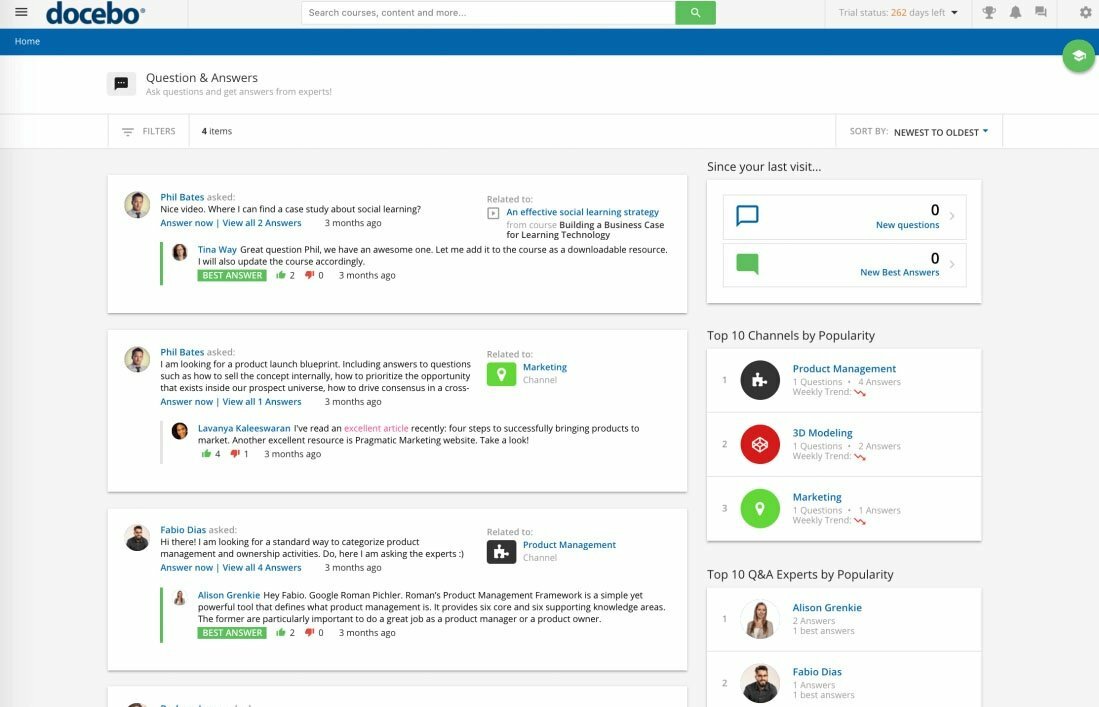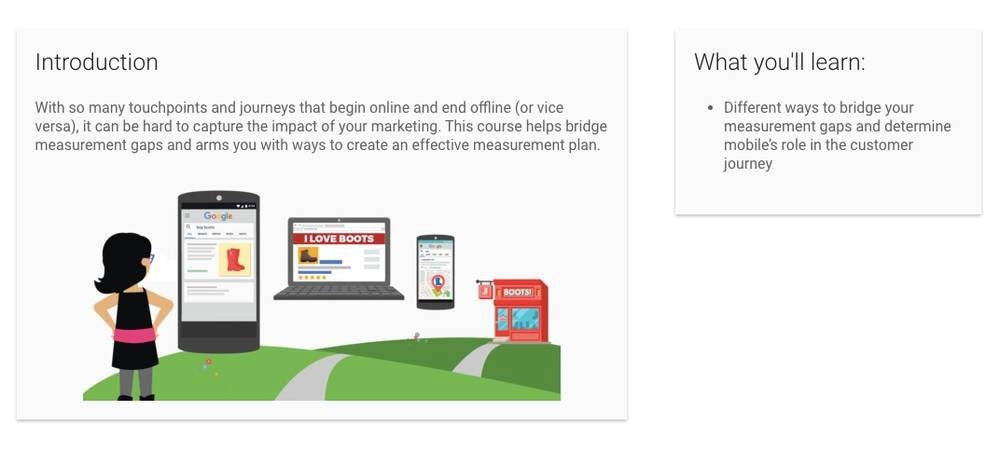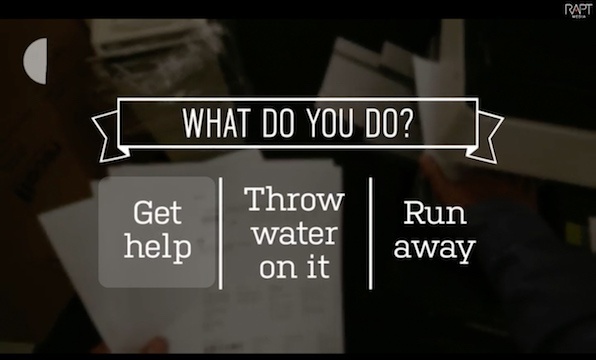Interactivity paired with smart videos: this is what eLearning looks like in 2019! Find out everything you need to know to take your company to the next level in the sustainable transfer of knowledge with our detailed guide.
No desire to read? Listen to the blogcast:What is eLearning?
Jump directly to the appropriate section:
How your company can benefit from eLearning.
Why Video?
What makes a high-quality eLearning video?
Your own eLearning video.
The eLearning of the future.
Your own eLearning project.
In order to be really successful in what we do professionally, we have to stay up-to-date. After all, learning doesn't just stop once we’ve received our degree.
However, 81% of online marketers, for example, do not have access to effective training programs. Yet in an industry as quickly-changing as marketing, employees need to be able to continue their education. The situation is similar in other jobs.
This is where the concept of eLearning comes into play. Through digital learning programs that are available for an unlimited period of time, employees can familiarize themselves with new software at their own pace.
Simple eLearning example: Introduction to the Python course at Harvard University.
Increasingly, videos come into play with this electronic learning content. No wonder, considering that by 2020 videos will account for 82% of Internet traffic. But before we show you how you can benefit from eLearning videos, let's first clarify a few terms.
What exactly is eLearning?
eLearning is the term used to describe learning using digital media to access educational content outside a traditional classroom. In fact, eLearning includes those times you’ve looked at an Excel tutorial on YouTube or clicked through an online recipe blog.
eLearning content (also called Learning & Development, or L&D for short) can be delivered through a Learning Management System (LMS) or video conferencing software. Depending on the platform used, there are several interactive ways to communicate or collaborate. Thus, understanding can be evaluated through tests. Certain features also allow learners to create and share content, such as mind maps, together.

In the LMS Docebo, learners can easily ask questions and communicate with each other.
The following statistics show that eLearning and the use of videos are trendy:
- By 2019, one out of two courses will be conducted online.
- 98% of companies want to use video for their digital learning content.
- The use of eLearning in companies has increased by 900% in the last 16 years.
eLearning: Reaching your goal through interactivity.
An essential feature of an eLearning course is interactivity: Participants have various control and intervention options and can frequently get in touch with their teachers or other learners. Some courses are pre-built and can be completed at the learner’s own pace, while others are even broadcasted live so that questions can be asked in real time via "electronic hand raising.”
During an e-learning course, the participant deals with various media such as videos, texts, graphics, etc. The course is designed to be a hands-on, interactive learning experience. Usually in the middle or at the end of each small module, assessments can be taken. For example, in the form of a short quiz or a memory game, what has been learned is evaluated and consolidated. In particular, personal engagement and active involvement with the contents promotes faster learning for the participant.
How your company can benefit from eLearning.
#1 Time Savings.
eLearning gives you the greatest possible flexibility in terms of time and space. Compared to classical classroom training, neither instructors nor users are tied to fixed schedules and do not have to invest in travel expenses. Google, for example, was able to increase the number of YouTube experts trained annually tenfold by developing a certified video training course. Your company can train more employees at a faster rate through eLearning.
#2 Cost savings.
eLearning requires much less staff than hiring an expensive instructor for each course – not to mention the facility and accommodations that would need to be provided. And because a program license can be used indefinitely by all interested parties, the content becomes more accessible and affordable for participants.
""The Case for Continuous Learning": PayPal's Chief Learning Officer Derek Hann explains how eLearning works.
#3 Consistent quality.
By producing your eLearning course once, you avoid variations in teaching. The success of your course does not depend on the daily fluctuation of the instructor, and by selecting the appropriate electronic training measure, you guarantee consistent quality.
#4 Multilingualism.
This point is particularly advantageous for international companies: the same eLearning course can be presented in different languages. This means that it can be used even more widely and individually, instead of always offering classroom training exclusively in the predominant corporate language.
#5 Higher ROI.
Every time an employee logs into your eLearning course, your return on investment (ROI) increases – because the knowledge is already available, it flows directly back into your organization and doesn't cost you time to respond to a support request. Bloomingdale's saved over $3 million by using online training.
eLearning: This is why you should rely on video.
Suppose you are an aspiring photographer who has just purchased his first semi-professional SLR camera. You've read the manual but found it difficult to understand the color settings. Now, of course, you want to know more, experience the camera in-action, and watch a demonstration. What do you do?

Videos: The medium of choice for product questions or skill demonstrations.
There's a good chance you'll end up on YouTube sooner or later. In second place among the most visited websites in the world (behind Google), you're guaranteed to find what you're looking for. In fact, 3 out of 4 users prefer video content to plain text. They are easier to consume and deliver more information in less time.
People differ, of course, in the way they prefer to receive information—whether visually, audibly, by reading it, or practically: "learning by doing.” By using video, you can incorporate elements of any style into your eLearning information while improving the learning experience:
- The use of video formats offers extensive storytelling possibilities.
- Our brain processes video about 60,000 times faster than pure text.
- When texts are combined with visual content such as an explainer video, we remember the information up to 6 times better.

Video, graphics, and text explanations: This eLearning course teaches through multiple channels.
What makes a high-quality eLearning video?
A scientific study conducted by Vanderbilt University found the following recommendations for a successful online educational video:
- Keep your video short and tune it precisely to your learning goals.
- Accentuate explanations with auditory and visual elements.
- Divide your content into blocks that are easy to consume.
- Emphasize important concepts with colors and symbols.
- Use a casual, entertaining style to appeal to your audience.
- Use questions, interactive elements, or additional tasks to encourage active learning with your eLearning video.
- Optimize your eLearning content for mobile devices for even easier consumption.
Furthermore, the following features have proven to be successful in eLearning videos:
Gamification: Playful approach to success.
3 out of 4 employees are at least occasional gamers. Thus, playful approaches have found their way into learning management systems. For example, Cisco 2014 has added playful elements to its social media program, stimulating motivation and healthy competition between employees. Since then, 650 employees have successfully completed nearly 13,000 courses.
Create a community among learners.
Employees with good social contacts in the workplace are happier and more motivated, less likely to change jobs, and up to 12% more productive. Use your LMS to connect colleagues and integrate new employees faster. In this way, they can motivate each other and effectively exchange their individual expertise.
The learning management system Docebo explains the added value of social learning for employees.
Integrate interactive content.
81% of marketers agree that interactive content generates and retains more attention than static content. In order to engage your audience, you can add interaction possibilities between individual clips, such as a short quiz or memory game. You can also give your viewers a sense of control by allowing them to pause, skip, or rewind.

RIT's Teamwork eLearning course provides an evaluated quiz at the end of each module.
Micro-learning: Subdivide your content.
Technological progress changes the eLearning experience continuously. In 2018, for example, artificial intelligence, personalized learning experiences, and micro-learning are on the rise. Micro-learning means that the trend is moving from extensive learning modules to a small selection of precise, concise content that can be easily consumed.
Storytelling: Tell a thrilling story.
We remember information 22 times better when it's embedded in a story. By linking knowledge to emotions, more parts of our brain are activated. And through the neurotransmitter dopamine released in the process, we can better remember the moment associated with the emotion. Storytelling is the promising keyword here.
eLearning video by Myndon the topic of blockchain: skillful storytelling to convey difficult topics.
Create your own eLearning video in 3 steps.
If you have decided to create your own eLearning video, we have compiled the most important steps for you below. With the help of tools and tutorials available today, it is quite possible for you to create your own eLearning video.
However, allow enough time for this and be aware that the quality of your video is dependent upon your software’s framework and your own capabilities.
#1 Preparation: Set the learning goal.
Don't just produce your content to keep up with progress — be precise in your message. Why does a video fit into your eLearning course, and what do you want to convey with it?
You should think about the following elements before production:
- Concept: Design a gripping story or informative sequence tailored to your learning objective to keep your audience happy.
- Branding: Choose a color scheme and design that suits your company.
- Visuals: Use consistent graphics and animations or hire professional actors to add visual elements to your story.
- Sound: Use background music and sound effects to accompany your explanations.
- Voice Over: Engage a professional speaker to narrate your video.
For example, you can demonstrate a specific physical activity, summarize the content of a module, emphasize an important concept, or underline what you have learned with emotional elements. Record what visual elements your video must contain to successfully communicate your defined learning goal.
Asana uses this short How-To video to explain its calendar tool.
Also convey a "What you'll learn in this video" message right from the start. Take the real problem of your target group and describe briefly and precisely how you will solve it. Your viewers will know from the start what they are getting into and why they will benefit from your course.

Google shows you how: A precise, vivid description of the content of its marketing course.
You decide the style of the video depending on the point in the module and where you want to use it. While entertaining videos will appeal to your viewers, they won't do any good if they don't blend seamlessly into the surrounding content.
To keep your viewers' attention, make sure that you actively encourage them to join in, for example by prompting them to click or by "electronic hand raising" as described above.
#2 Production: Strive for perfection.
The next step is the implementation of your eLearning concept.
If, on the other hand, you want to create a real-life video and are behind the camera yourself, pay particular attention to the following during production:
In a nutshell:
1. Technical check: Do all cameras, microphones, software, etc. work perfectly?
2. Safeguard: Don't rely on everything being perfect the first time. This will make post-processing easier for you.
3. Fine-tuning: Is the speaker's voice easy to understand and stimulating? Is the exposure too strong or too weak? Can you bring more variety into the presentation from a different camera angle?
#3 Post-production: Get the most out of your video.
Finally, edit. Remember, less is more. It may seem difficult to cut out certain content, but always keep the overall learning objective of your video in focus. The shorter and more precise, the better!
If you notice that your content is still too long, divide it into multiple segments – Micro-learning. Focus each episode on a specific topic and allow your viewers to better remember what they've learned. Ideally, a single video should last no longer than 2 to 3 minutes before you include a short review or interactive exercise.
Finally, optimize your video with appropriate background music and visual effects without distracting from the actual content.
Make your video accessible from anywhere at any time. 90% of consumers watch videos on their smartphones – the same applies to short eLearning videos. So customize your video for mobile devices, include subtitles, and provide compressed versions for viewing on slow Internet connections.
Be inspired by these examples.
Whether animated explainer videos, interactive videos, or detailed product demonstrations – see here how other companies integrate videos into their learning courses.
The marketing automation platform Mailchimp produces various series of YouTube explainer videos to describe and demonstrate individual services of the software. In the following video, the company shows in an entertaining way how Instagram Ads can be created directly in Mailchimp.
Entertaining explanation: Instagram Ads created directly in Mailchimp.
Komplexe Sachverhalte verständlich erklärt: Um Kunden das neue Feature des “Komfort Check-Ins” nahezubringen, ließ die Deutsche Bahn einen animierten Erklärfilm produzieren.
Interactivity brings a playful factor into eLearning videos that ensures that what has been learned is remembered better and longer. This interactive recruitment video by Deloitte has been repeatedly named the best corporate video of 2014.

Not direct eLearning, but a great example of interactivity: This recruitment video from Deloitte.
The next video is part of an extensive eLearning course from Microsoft on the eLearning platform edX. Participants are shown in detail how the Sharepoint software works, along with tips and tricks.
Everything about Sharepoint: This video is part of the Microsoft eLearning course.
The trend is toward professionally-developed eLearning videos.
With the presented tips and steps, you can start your own eLearning project. However, Ryan Eudy, CEO of the eLearning company ej4, emphasizes that the trend is toward professionally-developed eLearning videos.
Think carefully about whether you want to create your own eLearning video. Despite the numerous features of available software, self-created videos are far from the quality of professional explainer video providers. For a design individually tailored to your content and creative communication of your defined learning goals, it is best to consult a professional video agency.
Market your eLearning course.
Whether you offer your eLearning course as mandatory for employees or as a tutorial for handling your product, you should present it as attractively as possible right from the start.
Learn more about the potential of moving images and how to sell more with video.
How to market your course: Boston Universitypresents its product management course in this detailed explainer video.
Tip:
Describe in detail who your course is aimed toward and what problem it solves.
Highlight the key points that participants will have learned after completing the course.
Write a specific description of the course, the subject matter, and how the knowledge gained will benefit your participants in the real world.
Use testimonials (e.g. from previous graduates) to confirm the effectiveness of your course.
A look ahead: What could eLearning look like in the future?
The eLearning industry has experienced a great upswing in recent years, and an end does not yet seem visible. For example, Ehsan Memari of the SkyPrep training software assumes that artificial intelligence will have an increasing influence on eLearning, for example by answering questions in real time or processing spoken words.
But virtual and augmented reality will also find their way into eLearning as technology advances. For example, the learner could interact with his virtual environment to train for critical scenarios as a doctor or rescue worker. Augmented reality, on the other hand, combines real and virtual content and offers the participant immediate feedback on his actions.
Florian Radke explains how augmented reality will change learning and increase our productivity.
Are you ready for your own eLearning project?
Whether you want to enable new employees to learn how to use a certain software efficiently or if you want to teach employees how to use a certain software: eLearning is a powerful tool for conveying educational content due to its flexibility, standardization, and time and cost efficiency. And above all, the use of moving images promotes an optimized learning experience for your participants.
We are happy to support you in the conception and implementation of your eLearning project »

